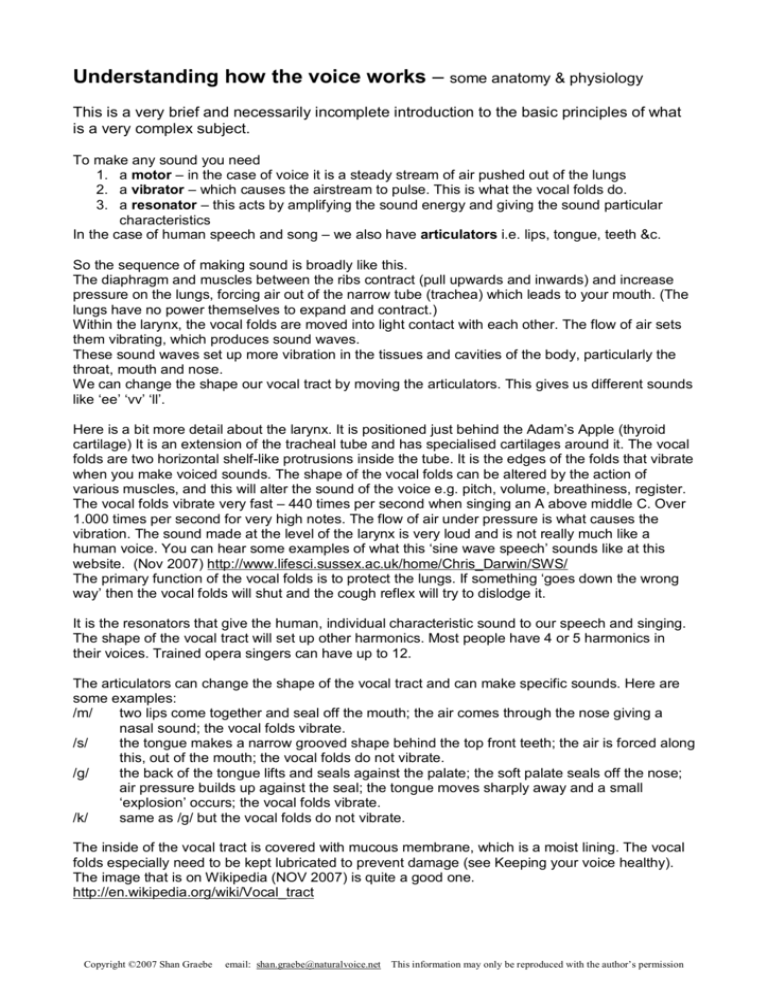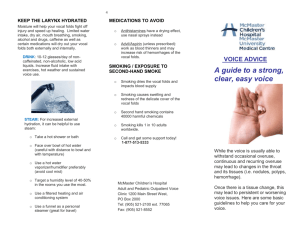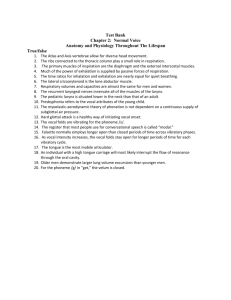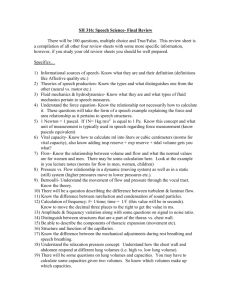Understanding How the Voice Works
advertisement

Understanding how the voice works – some anatomy & physiology This is a very brief and necessarily incomplete introduction to the basic principles of what is a very complex subject. To make any sound you need 1. a motor – in the case of voice it is a steady stream of air pushed out of the lungs 2. a vibrator – which causes the airstream to pulse. This is what the vocal folds do. 3. a resonator – this acts by amplifying the sound energy and giving the sound particular characteristics In the case of human speech and song – we also have articulators i.e. lips, tongue, teeth &c. So the sequence of making sound is broadly like this. The diaphragm and muscles between the ribs contract (pull upwards and inwards) and increase pressure on the lungs, forcing air out of the narrow tube (trachea) which leads to your mouth. (The lungs have no power themselves to expand and contract.) Within the larynx, the vocal folds are moved into light contact with each other. The flow of air sets them vibrating, which produces sound waves. These sound waves set up more vibration in the tissues and cavities of the body, particularly the throat, mouth and nose. We can change the shape our vocal tract by moving the articulators. This gives us different sounds like ‘ee’ ‘vv’ ‘ll’. Here is a bit more detail about the larynx. It is positioned just behind the Adam’s Apple (thyroid cartilage) It is an extension of the tracheal tube and has specialised cartilages around it. The vocal folds are two horizontal shelf-like protrusions inside the tube. It is the edges of the folds that vibrate when you make voiced sounds. The shape of the vocal folds can be altered by the action of various muscles, and this will alter the sound of the voice e.g. pitch, volume, breathiness, register. The vocal folds vibrate very fast – 440 times per second when singing an A above middle C. Over 1.000 times per second for very high notes. The flow of air under pressure is what causes the vibration. The sound made at the level of the larynx is very loud and is not really much like a human voice. You can hear some examples of what this ‘sine wave speech’ sounds like at this website. (Nov 2007) http://www.lifesci.sussex.ac.uk/home/Chris_Darwin/SWS/ The primary function of the vocal folds is to protect the lungs. If something ‘goes down the wrong way’ then the vocal folds will shut and the cough reflex will try to dislodge it. It is the resonators that give the human, individual characteristic sound to our speech and singing. The shape of the vocal tract will set up other harmonics. Most people have 4 or 5 harmonics in their voices. Trained opera singers can have up to 12. The articulators can change the shape of the vocal tract and can make specific sounds. Here are some examples: /m/ two lips come together and seal off the mouth; the air comes through the nose giving a nasal sound; the vocal folds vibrate. /s/ the tongue makes a narrow grooved shape behind the top front teeth; the air is forced along this, out of the mouth; the vocal folds do not vibrate. /g/ the back of the tongue lifts and seals against the palate; the soft palate seals off the nose; air pressure builds up against the seal; the tongue moves sharply away and a small ‘explosion’ occurs; the vocal folds vibrate. /k/ same as /g/ but the vocal folds do not vibrate. The inside of the vocal tract is covered with mucous membrane, which is a moist lining. The vocal folds especially need to be kept lubricated to prevent damage (see Keeping your voice healthy). The image that is on Wikipedia (NOV 2007) is quite a good one. http://en.wikipedia.org/wiki/Vocal_tract Copyright ©2007 Shan Graebe email: shan.graebe@naturalvoice.net This information may only be reproduced with the author’s permission








